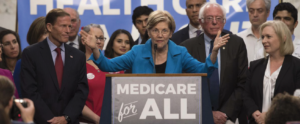
Democratic Senator Elizabeth Warren insisted, “We don’t need to raise taxes on the middle class by one penny to finance Medicare for All.” Photo courtesy of Vox
After months of criticism from opponents, Elizabeth Warren finally released an outline on how she plans to pay for “Medicare for All,” her ambitious initiative aimed to cover all Americans under public health care without premiums or deductibles. Warren’s main statement within the plan underlined a series of taxes on businesses and the wealthy, all without “one penny in middle-class tax increases.” In three words: it’s a disaster.
Warren designed a ten-year plan which requires “just under” $21 trillion from the U.S. government. How is the government going to fund that? Simple. They’re going to impose draconian-style taxes on the rich and on businesses. Let’s break it down.
The first of such taxes would be a wealth tax on the rich: anyone with a net worth of $50 million and above. Any dollar held above that number would be taxed two cents a year, while a dollar held above $1 billion would see a six-cent tax. It seems straightforward, but it has major flaws that Warren refuses to acknowledge.
Warren’s plan predicts that over the next ten years, this tax can generate $2.75 trillion in revenue. But archaic statistical analyses like these always assume that no changes will happen from imposing this sort of system. For reference, out of the 14 European countries that implemented a wealth tax in 1994, all but four repealed it, in light of low tax yields and poor results. As soon as a tax like this would be proposed, millionaires and billionaires would depart en masse, leaving Warren’s estimate of $2.75 trillion in the dust. Warren attempts to circumvent this by placing a 40% exit tax on all assets of someone renouncing their citizenship, but by the time this tax would go into effect, most wealth would be gone anyway. And as the estimates start falling short, as they always do, will the taxing thresholds be reduced, affecting even more people?
Second, money is mobile. Most people assume that the rich’s wealth is sitting in a bank, or maybe in assets like mansions and luxury cars. But this assumption is wrong. This wealth that Sanders and Warren talk about isn’t sitting around idly but is invested in other money-producing, economy-stimulating activities. It’s invested in companies, used in research and development to create better products for consumers, and borrowed by investors and entrepreneurs seeking to drive their businesses and ventures.
But money is easily spooked. With these taxes being put in place, investments might stop as the wealthy pull their money out of the economy. This loss of movement will stagnate the American economy, curbing innovation, growth, and stimulation.
The third problem, and arguably the most important, is the fact that this tax is unconstitutional. Article I, section 9 of the constitution reads “No Capitation, or other direct Tax shall be laid, unless in Proportion to the Census or Enumeration herein before directed to be taken.” This means that if the federal government is going to levy a direct tax against the people, it must require every person to pay the same amount within the state, no matter income or socioeconomic class. Warren’s wealth tax doesn’t fall within those parameters, focusing on the richest in our country. So the debate becomes: what is an indirect and direct tax, and is the wealth tax a direct tax?
The basic answer regarding definitions — since there hasn’t been a precedent set by a high court — is that a direct tax is related to one’s state of being, while an indirect one applies to an action, like a business transaction. In 1895, the case Pollock v. Farmers’ Loan & Trust Co. was brought to the Supreme Court regarding the issue of a new federal income tax. The Supreme Court ultimately struck down the tax, citing that because they were taxing income generated from the property, it was essentially a property tax, making this tax a direct tax. Because it wasn’t spread equally throughout the state, the tax was declared unconstitutional. Only until the 16th Amendment was adopted 17 years later did federal income taxes make a comeback, the new amendment specifying that the direct and indirect rules still apply, except in the case of income taxes, which were seen as neither, and allowable by the federal government. Warren seeks to tax all assets, including property owned by individuals. Considering the outcome of Pollock v. Farmers’ Loan & Trust Co., Warren’s tax would almost certainly ultimately be ruled a direct tax, making it unconstitutional.
Even with all of these problems, the wealth tax covers only $2.75 trillion of her plan. Most, if not all, of the rest of her planned revenue comes from her aggressive taxes on private businesses and corporations. Once in office, Warren immediately plans to slap a 35% tax on all businesses, opposed to the current 21% tax. Besides this, any money that large businesses are currently paying to their health-insurance providers will instead have to be paid to the federal government (since, of course, insurance providers will no longer exist, the government funding healthcare). In theory, this sounds great, but this actually punishes businesses who already give their employees good healthcare. Those employers will be paying the same high rate as before, only now the benefits the workers get are the same as everyone else’s, even if competitor employers are paying a third of what the others are. This inequality will hurt many companies.
Warren’s plan to pay for “Medicare for All” is unrealistic and fails to recognize the incredible fallout from such a project. If put into practice, this policy would wreak havoc on the economy and the country. “Best case, slow phase into chronic slow growth,” said Douglas Holtz-Eakin, former chief economic adviser to the late Senator John McCain. “Worst case, shock therapy recession followed by chronic slow growth.”
To truly solve the crisis of healthcare in America, we can’t rely on the government to solve the problem for us. We need to innovate — we must create competition to drive prices down. To do this, we only have to look to the most powerful, most influential tool available to a democratic, capitalist society: the power of a free market.




